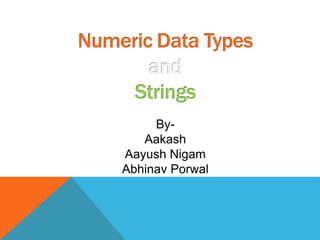
Data types.pdf
- 2. A data type is a class of data objects with a set of operations for creating and manipulating them. Examples of elementary data types: integer, real, character, Boolean, enumeration, pointer.
- 3. Numeric Data Types Enumerations Boolean Characters Character Strings Pointers & Programmer- Constructed Data Objects Files & Input-Output
- 4. NUMERIC DATA TYPES • A numeric <data type> is defined by a descriptor that contains four pieces of information: • The <data type>'s name: either INTEGER, SMALLINT, NUMERIC, DECIMAL, FLOAT, REAL or DOUBL E PRECISION. • The <data type>'s precision. • The <data type>'s scale (for exact numeric types). Whether the <data type>'s precision and scale are expressed in decimal or binary terms.
- 6. INTEGERS In computer science, an integer is a datum of integral data type, a data type that represents some finite subset of the mathematical integers. Integral data types may be of different sizes and may or may not contain negative values. Cont.
- 7. Maximal and minimal values. The maximum integer value is sometimes represented as a defined constant (eg- in Pascal, it is the constant maxint.) • Arithmetic Operations • Relational Operations • Assignment Operations • Bit Operations Hardware defined.
- 8. SUBRANGES A subrange type defines a subset of the values of a particular type. By using subrange types, you can easily detect errors occuring due to unreasonable values of a variable which shouldn't take values outside a given boundary. Subrange types can be defined of type character, integer, in no case real! Cont.
- 9. Subtype of integer A sequence of integer values within some restricted range Pascal declaration A: 1..10 means that the variable A may be assigned integer Values from 1 through 10. Smaller storage requirement, better type checking
- 10. FLOATING-POINT REAL NUMBERS The encoding scheme for floating point numbers is more complicated than for fixed point. The basic idea is the same as used in scientific notation, where a mantissa is multiplied by ten raised to some exponent. For instance, 5.4321 × 106, where 5.4321 is the mantissa and 6 is the exponent. Cont.
- 11. Minimum and maximal value Round-off issues – the check for equality may fail due to round-off. • Arithmetic Operations • Relational Operations • Assignment Operations • Bit Operations Mantissa – exponent model. Example: 10.5 = 0.105 x 10, Mantissa: 105, Exponent:2
- 12. FIXED-POINT REAL NUMBERS In computing, a fixed-point number representation is a real data type for a number that has a fixed number of digits after (and sometimes also before) the radix point(after the decimal point '.' in English decimal notation). Cont.
- 13. Real numbers with predefined decimal places • Arithmetic Operations • Relational Operations • Assignment Operations • Bit Operations Directly supported by hardware or simulated by software
- 14. Involves a complex data structure organization by the compiler. Character Strings Pointers & Programmer Constructed Data Objects Files and Input-Output TYPES
- 15. In computer programming, a string is traditionally a sequence of characters, either as a literal constant or as some kind of variable. The latter may allow its elements to be mutated and the length changed, or it may be fixed (after creation). Cont.
- 16. Cont. • Fixed declared length: storage allocation at translation time. Strings longer than the declared length are truncated. • Variable length to a declared bound: storage allocation at translation time. An upper bound for length is set and any string over that length is truncated. • Unbound length: storage allocation at run time. String can be of any length with in the range.
- 17. Cont. • Concatenation – appending two strings • Relational – equal(=), less than(<), greater than(>) • Substring selection – using positioning subscripts • Substring selection – using pattern matching • Input/output formatting • Dynamic strings – the string is evaluated at run time.
- 18. • Fixed declared length: A packed vector of characters • Variable length to a declared bound: a descriptor that contains the maximum length and the current length • Unbound length: Either a linked storage of fixed-length data objects or a contiguous array of characters with dynamic run-time storage allocation.